
Inserting a roast in the oven is an economical way to manage time in the kitchen. With a small amount of preparation and only the occasional check, roasting provides a main course without a high amount of monitoring. The standard roasting temperature of pork is 350 degrees F, but you can increase or decrease the temperature depending on the type of cut you are using, whether cooking with moist or dry heat and the time you plan to leave it in the oven. Whatever temperature you use to cook a pork roast, check the internal temperature when done with a meat thermometer; for food safety's sake, the interior of a pork roast should be at 145 degrees F or above.
Meat Cut
Roasting times vary depending on the cut, because different cuts have heat permeate faster or slower throughout. A tenderloin roasted at a higher heat of 425 degrees F typically takes only 20 to 27 minutes cooking time for a 1/2 pound to 1 1/2 pound roast. For a crown roast of 10 pounds, the cooking time is generally 12 minutes per pound at 350 degrees F. Smaller pieces of meat cook faster than larger pieces. Bone-in roasts are generally more flavorful than their boneless counterparts, but take a longer period of time to cook through.
Moist vs. Dry Cooking
Temperatures for moist cooking, which uses steam from liquids or watery foods such as fruit to cook the meat, tend to be higher than their dry cooking counterparts. A dry heat at 250 degrees F slowly breaks down the proteins in the meat, retaining moisture and flavor, while higher temperatures can dry out the meat. Moist cooking not only retains moisture by using a closed container, but can add moisture through additional ingredients and liquids. This reduces the need for lower temperatures to minimize moisture loss. Generally roasts can be cooked at 350 to 375 degrees F with moist cooking techniques.
Time
Time and temperature are strongly tied together in the cooking process. The longer a roast remains in the oven, the lower the temperature should be; shorter times require higher temperatures. If you can leave a roast in for 6 to 8 hours, use the lowest heat possible, 250 degrees F, to obtain the juiciest roast. If you can monitor a shoulder roast for 3 hours, cook at 375 degrees F.
Considerations
Add in vegetables during the slow-cooking process to add moisture and flavor to the meat as it cooks. Cut a few holes deep into the pork and insert pieces of garlic, onion, or even candied orange rind for extra flavor throughout the meat. When slicing, cut against the grain, as this makes each slice more tender. Allow the roast to rest, covered, for at least 10 minutes before cutting to let the juices settle evenly in the meat.
Related Articles

How to Cook a Standing Rib With the ...
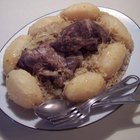
How to Cook a Boneless Sirloin Pork ...
How to Cook Pre-Seasoned Porketta
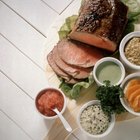
How to Defrost a Frozen 4 Lb Roast
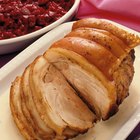
Should You Cover a Pork Roast & Add ...

How to Cook Beef Top Round Pot Roast

Can You Bake Sliders?
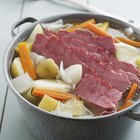
How to Cook a Large Amount of Corned ...

How to Make a Blackbuck Antelope Roast

How to Make quick Meat Loaf

How to BBQ the Eye of Round Roast

How to Sugar Cure Bacon
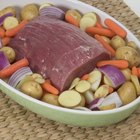
How to Make Bottom Round Roast Melt in ...

How to Grill a Ribeye on a Weber Q
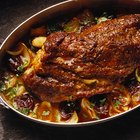
How to Use a Roaster for Pork

How Long Does It Take to Cook a ...

Cook Time for Boiled Pork Roast
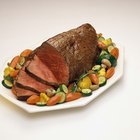
Internal Temp of Rare Roast Beef

How to Tell If a Pork Roast is Done

How to Slow-Cook Meat in the Oven
References
Writer Bio
Based in Kingston, Canada, Samantha Lowe has been writing for publication since 2006. She has written articles for the "Mars' Hill" newspaper and copy for various design projects. Her design and copy for the "Mars' Hill" won the Associated Collegiate Press Pacemaker award in 2008. Lowe holds an Honors BA from Trinity Western University, and a MSc in Occupational Therapy from Queen's University where she is currently doing her PhD.
Photo Credits
Eising/Photodisc/Getty Images